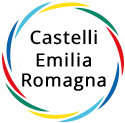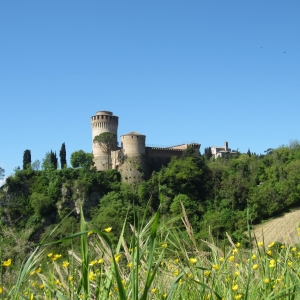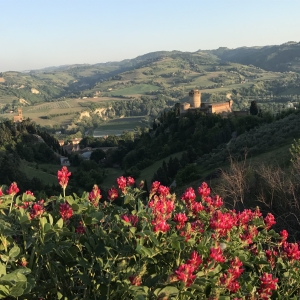Rocca dei Veneziani
The Fortress of Brisighella, built at the beginning of the 14th century and restored by Astorgio Manfredi (1457) and the Venetians (1504-1508), is located in a dominant position over the historic centre of Brisighella and in a panoramic position with respect to the Chalk Vein and the Lamone valley; it is home to the museum dedicated to the relationship between Man and Chalk.
Articulated around a vast trapezoidal-shaped inner courtyard, the fortress has two circular towers at the north-east and south-east corners, flanking the entrance, whose overlapping rooms have lent themselves to being set up as exhibition and multimedia spaces.
The proper exhibition section dedicated to the relationship between Man and Chalk was therefore set up in the north-eastern tower, which is smaller in height and size than the south-eastern tower (Venetian tower).
The spaces have been exploited according to an ascending route that starts to the right of the main entrance. The three small circular rooms, arranged along the staircase and superimposed one on top of the other, were used to place panels with images and captions dedicated to the presence of man in the Chalk Vein between prehistoric times and the Middle Ages, declined through the identification of some symbolic places: the caves, mainly occupied for funerary and cultic purposes between Prehistory and the Iron Age (Tanaccia Cave and/or the Bandits' Cave); the settlements linked to the exploitation of lapis specularis in Roman times (Carnè Roman house and/or Lucerna quarry); the medieval fortifications (Rontana Castle).
This ascending itinerary, which tends to re-propose in the verticality of the spaces the eras of human occupation of the Chalk Vein, culminates, in the largest upper room, with the exhibition of finds unearthed during excavation and reconnaissance campaigns conducted under the scientific direction of the Superintendence for the Archaeological Heritage of Emilia Romagna and the University of Bologna, illustrated by educational panels. The exhibition has been set up in showcases and some of the most representative contexts investigated in the Chalk Vein have been selected, i.e. the finds from the Grotta dei Banditi for the pre-protohistoric period; the materials from the Roman house of Carnè, the Lucerna quarry, the first lapis specularis quarry identified in Italy, and the Zattaglia and Monte Mauro area for the Roman period; and the materials found in the Rontana castle for the medieval period. The
section specifically dedicated to the relationship between Man and Chalk was flanked by a second didactic section concerning the building of the Rocca. To this end, didactic panels dedicated to the history of the Fortress and the function of the individual rooms have been placed in both the outdoor and indoor spaces. In addition, two settings have been set up in the rooms of the south-eastern tower: the bedroom and kitchen with their furniture faithfully recreated in medieval style and reproductions of kitchen and tableware. The route inside the Venetian tower culminates in the upper room, open to the surrounding landscape.







